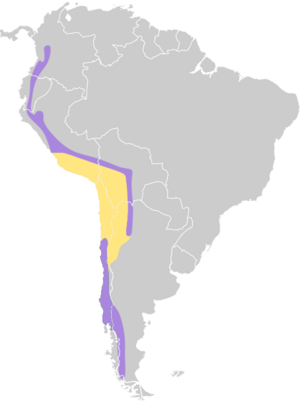White-throated hawk facts for kids
Quick facts for kids White-throated hawk |
|
|---|---|
 |
|
| Conservation status | |
| Scientific classification | |
| Genus: |
Buteo
|
| Species: |
albigula
|
 |
|
The white-throated hawk (Buteo albigula) is a type of bird of prey found in parts of South America. These birds are also known as "soaring hawks" because of how they fly high in the sky. They belong to the family Accipitridae, which includes many eagles, hawks, and kites. You can find them in countries like Argentina, Bolivia, Chile, Colombia, Ecuador, Peru, and Venezuela.
Contents
What is a White-throated Hawk?
For a while, scientists weren't sure if the white-throated hawk was its own unique bird. Some thought it might be a subspecies of the short-tailed hawk. Others believed it was a "sister species," meaning it was very closely related. However, today, scientists agree that the white-throated hawk is its own distinct species. It is the only type of white-throated hawk, meaning it has no subspecies.
How to Identify a White-throated Hawk
The white-throated hawk is about 38 to 48 centimeters (15 to 19 inches) long. Its wings can spread out from 84 to 102 centimeters (33 to 40 inches). Female hawks are usually up to 20% larger than males. Both male and female hawks look very similar in color.
Adult Hawk Appearance
Adult white-throated hawks have a brownish-black face and upper body. Their tail is dark brown on top and grayish underneath. It has up to 10 thin dark bands. Their chin, throat, and belly are white. They have brown streaks on their chest and belly. Their upper legs (thighs) have reddish-brown bars. Their eyes are brown, and their beak base (cere), legs, and feet are yellow.
Young Hawk Appearance
Young hawks look a lot like adults. However, they have heavy blackish streaks on their chest and sides. Their cheeks are also streaked, and their thighs are buff-colored with brown bars.
Where White-throated Hawks Live
White-throated hawks live in the Andes mountains. This mountain range stretches from northwestern Venezuela all the way south through Colombia, Ecuador, Peru, and Bolivia. They are also found in central Chile and western Argentina.
Hawk Habitats
These hawks prefer to live in humid mountain forests. They can be found in "elfin forests," which are forests with small, twisted trees. They also live in cloudforests, which are forests often covered in clouds. Sometimes, they live near open areas like puna grassland.
Hawk Elevation
In the northern parts of their range, they live at high elevations. This can be between 1,700 and 3,500 meters (5,600 and 11,500 feet) above sea level. In Patagonia, they are found between 1,000 and 2,000 meters (3,300 and 6,600 feet). In Chile, they can live from near sea level up to 1,200 meters (3,900 feet).
White-throated Hawk Behavior
Hawk Movement and Migration
White-throated hawks living in the southern parts of their range definitely migrate. They move north when it's not their breeding season. Scientists are not as sure about the hawks in the northern areas. Some think all northern sightings are from hawks migrating from the south. Others believe some hawks live there all year. They also think some southern migrants might visit during the austral winter. The American Ornithological Society lists them as visitors to Bolivia and Ecuador. This suggests they only pass through these countries during migration.
What White-throated Hawks Eat
Scientists haven't fully studied how white-throated hawks hunt. Their diet is also not completely known. However, we do know they eat insects, small rodents, and other birds. They can even catch birds as large as the Magellanic woodpecker.
Reproduction and Life Cycle
White-throated hawks are mainly known to breed in Chile and Argentina. There is some limited evidence they might also breed in northern areas. Their breeding season starts in September and lasts at least until April. During courtship, pairs fly in wavy patterns.
Nests and Eggs
Their nests are made from live and dead sticks. They often cover the nest with lichen to help it blend in. Nests are usually placed high up in trees, about 13 to 22 meters (43 to 72 feet) above the ground. A female hawk usually lays one or two eggs. The female does most of the incubating, which means sitting on the eggs to keep them warm.
Chicks and Fledging
The eggs hatch after about one month. The young hawks leave the nest (fledge) about 40 days after they hatch. The male hawk brings food to the female and the young chicks.
Hawk Sounds
The white-throated hawk is thought to be mostly quiet. However, during the breeding season, it makes a "squealing 'kee-ah'" sound.
Conservation Status of the White-throated Hawk
The IUCN (International Union for Conservation of Nature) has assessed the white-throated hawk. They have listed it as a species of "Least Concern." This means that the hawk is not currently in danger of disappearing. It has a fairly large area where it lives.
Population and Threats
The estimated number of mature white-throated hawks is between 670 and 6,700 individuals. Scientists don't know if this number is going up or down. No immediate threats to the species have been found. In its known breeding areas, it is considered uncommon to fairly common. However, in much of its northern range, it is rare and found only in specific places. The hawk's preferred mountain habitats are less affected by human activities. It can also tolerate some disturbed areas.


